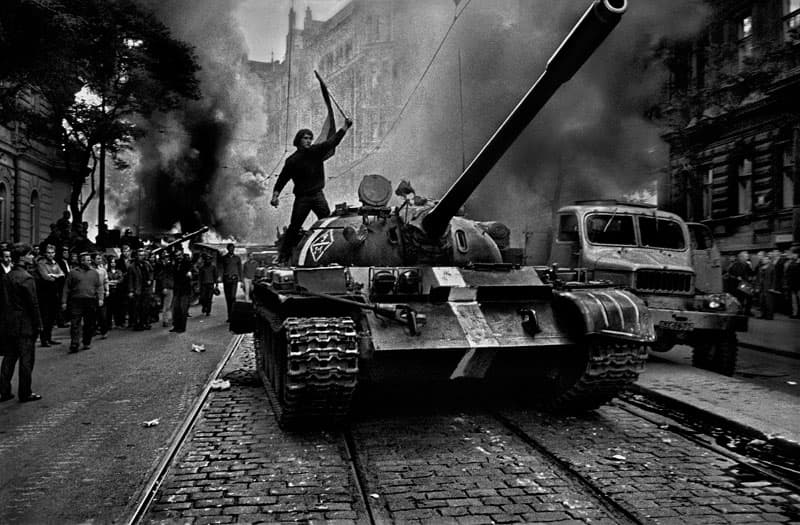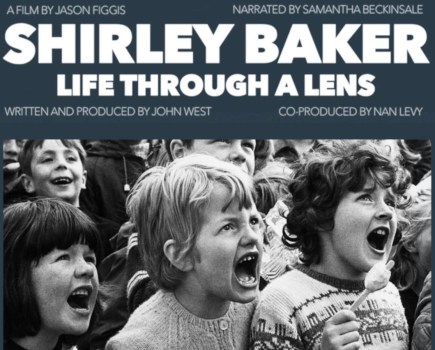Image: Warsaw Pact tanks invade Prague, Czechoslovakia, August, 1968 © Joseuf Koudelka/Magnum Photos
Josef Koudelka has long been widely regarded as one of the greatest living photojournalists, yet he remains an outsider who lives out the ideal of the romantic artist. For most of his adult life he has lived a rootless, semi-nomadic existence, travelling widely and photographing compulsively. He pursues his own personal projects, refuses to shoot editorial or commercial work, and rarely does interviews.
Although he is best known for his extraordinary images of the Warsaw Pact’s invasion of Czechoslovakia in 1968, this was a rare foray into ‘news’ photography. Most of his work focuses on documenting everyday lives of ordinary people, usually outsiders, travellers or exiles, or landscapes transformed by human activity.
He first became fascinated by photography in his mid-teens, but initially had no plans to become a photographer. He was mainly interested in aircraft design and, after graduating with an engineering degree from Prague University in Czechoslovakia, he worked as an aeronautical engineer for several years. From the time he was at university, however, photography gradually grew to became the major passion in his life.
His first paid photographic assignments were shot for the Czech theatre magazine Divadlo in 1961 and he continued his association with the theatre for several years. When the famous avant-garde Theatre Behind the Gate was founded in Prague in 1965, Koudelka became the in-house photographer.
He wasn’t interested in conventional theatre photographs, and experimented with abstract and often distorted images. The results were often intense and compelling. When Koudelka finally gave up his engineering career in 1967, theatre photography provided him with an income.
From 1962 onwards Koudelka was also working on his first major project, photographing gypsy communities. Their behaviour, lifestyle and appearance fascinated him, and later he went on to photograph gypsies in Romania, Hungary, Spain and France. He had plans to publish a book of these photographs, but in 1968 his life was unexpectedly changed.
On 21 August, the Russian authorities, angered by the liberal political reforms introduced by Czech leader Alexander Dubcek, sent hundreds of thousands of Warsaw Pact troops to occupy the country to re-establish Communist control and reverse the reforms. As the occupying army’s tanks began to enter Prague, Koudelka instinctively knew it was important to capture what was happening.
‘I had never photographed anything that you would call “news”,’ he later commented in the book Magnum Stories. ‘Suddenly, for the first time in my life, I was confronted with that kind of situation. I responded to it. I knew it was important to photograph, so I photographed. I didn’t think much about what I was doing. Later, some people told me that I could have been killed, but I hadn’t considered that at the time.’
Koudelka photographed the invasion and the violent street protests that immediately followed, and during the following seven days shot more than 5,000 photographs. He was in the thick of the action, and on one occasion he was fired at and chased by invading troops and only escaped by disappearing into the crowds of protestors.
These violent and dramatic scenes made extremely newsworthy subjects, but getting them published could have resulted in Koudelka’s arrest and his family’s persecution. When a selection of his ‘invasion’ images were published in The Sunday Times a year later, Koudelka was not named as the photographer; the byline was P.P. (Prague Photographer).
‘From that moment,’ Koudelka told The Guardian in 2008, ‘I was afraid to go back to Czechoslovakia because I knew that if they wanted to find out who the unknown photographer was, they could do it.’
After working in England on a three-month visa, Koudelka applied for political asylum in the UK and joined Magnum Photos the following year. Leaving his homeland was the beginning of Koudelka’s rootless, semi-nomadic existence. In his early years in the UK he would often sleep under a desk in the Magnum office, or on a friend’s floor, or even under the stars; he lived on small grants and awards given by arts organisations.
After completing his work on Romany communities, his book Gypsies was finally published in 1975. It was followed by Exiles in 1988, a melancholy exploration of loneliness and alienation. After Koudelka’s return to Czechoslovakia in 1989, he began exploring the country’s landscape.
He focused on the Podkrusnohorí Region, an area devastated by industrial development, and the resulting panoramic photographs were published in his book The Black Triangle (1994). In recent years he has mainly photographed with his Linhof panoramic camera (which he used for his 2009 book Piedmont), although he still shoots with the Leicas used in his earlier work.
Koudelka is now 73 and has small apartments in Paris and Prague, but continues to travel often; during the past five years, he has photographed in countries including Israel, Jordan, Libya, Syria, Poland, France, England and the USA. Journalists who have met him say he is still youthful and energetic. He has three children by different women in different countries, but admits that he rarely sees them.
‘I still don’t have a car, a television, a mobile phone, a wife,’ he told The Sunday Times in 2008. ‘What I don’t have I don’t need. For me, the most important thing is to wake up in the morning, feel well, and go and take photographs.’
Biography
- 1938: Born on 10 January in Boskovice, a small village in the Czech province of Moravia
- 1952: Begins taking photographs at the age of 14
- 1956-61: Studies engineering at the Czech Technical University of Prague and afterwards works as an aeronautical engineer
- 1962: Photographs gypsies for the first time.This work becomes a long-term project
- 1963: Shoots photographs of theatre productions and has them published in theatre magazines
- 1967: Decides to abandon his career in engineering and devote himself to photography
- 1968: Photographs the Soviet invasion of Prague in August as Warsaw Pact forces move to crush the Czech reforms
- 1969: Awarded the Overseas Press Club’s Robert Capa Gold Medal for exceptional courage in photography
- 1970: Applies for political asylum in the UK after working in England on a three-month visa. Joins Magnum Photos the following year
- 1987: Becomes a French citizen
- 1991: Returns to Czechoslovakia from exile and begins to shoot panoramic photographs of the country’s industrial wasteland
- 2004: Presented with the Cornell Capa Infinity Award by the International Center of Photography in New York
Books and websites
Books: A general overview of Koudelka’s work is available in Koudelka by Robert Delpire (published by Thames & Hudson). Other books, including Invasion 68: Prague are available on www.amazon.co.uk. Gypsies will be reissued by Thames & Hudson on 3 October 2011.
Websites: A good selection of Koudelka’s work can be found on www.magnumphotos.com. Frank Horvat’s 1987 interview with Koudelka can be read on the ‘Entre Vues’ section of www.horvatland.com, while Sean O’Hagen’s 2008 interview can be found by searching for ‘Koudelka’ on www.guardian.co.uk.







